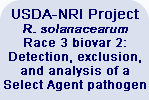Ralstonia solanacearum, which causes bacterial wilt on many crops, may be the world's most destructive bacterial plant pathogen. A subgroup known as race 3 biovar 2 (R3b2) causes potato brown rot and geranium wilt. R3b2 is distributed almost worldwide, but is not established in the United States or Canada. It is listed as a Select Agent for its potential to seriously damage both the potato and ornamental industries.
The United States is ill-prepared to cope with future introductions of R3b2 because our diagnostic tools lack the requisite sensitivity, specificity, and speed, and growers are not well educated about this pathogen. In addition, we do not understand R3b2's cold tolerance and specificity for potatoes, both epidemiologically critical traits. Latent infections of plant materials make detection of this bacterium nearly impossible without molecular diagnostic tests. None of the current diagnostic assays distinguish between R3b2 and other strains without lengthy confirmation tests, resulting in expensive quarantine and hold orders.
To address these serious deficiencies, we assembled a research team of experts in R. solanacearum diagnostics, molecular biology, epidemiology, and management with three specific aims:
-
Develop rapid, robust, and reliable diagnostic assays for R. solanacearum R3b2.
We will use two methods to generate specific antibodies to cell surface antigens present only in R3b2. These antibodies will be coupled to fluorescent nanoparticles for an ultra-sensitive diagnostic assay adaptable for field use. Mining of genomic sequence data will identify additional R3b2-specific PCR primer pairs that will form a second, independent and accurate diagnostic tool. Protocols using these new tools will be tested in multiple labs in the U.S. and offshore.
See accomplishments for Aim1.
- Identify R3b2 genes involved in cold adaptation and growth in plant hosts, using a
microarray-based post-genomic approach.
Comparative genomic analysis of an R3b2 strain, UW551, and a broad host range tropical tomato strain, GMI1000, suggest that ~10% of the UW551 ORFs are unique to this strain. We hypothesize that some genes encoding adaptation to the potato host and cold tolerance are among these 400 R3b2-unique ORFs. An alternative hypothesis is that these traits are encoded by genes present in both R. solanacearum genomes, but that differences in gene regulation produce the important phenotypic differences between the strains. Whole genome expression profiling of R3b2 and GMI1000 at various temperatures and during growth in different hosts offers a powerful means to test both these hypotheses.
See accomplishments for Aim2.
- Develop a package of optimized education and management training modules that will
educate stakeholders to
control this pathogen, primarily by exclusion.
Modules will be targeted for seed potato producers, regulatory scientists and diagnosticians, the ornamental industry, and plant pathology graduate students. Assessment is built into the project to ensure that new tools and outreach activities are changing behaviors in our target audiences.
See accomplishments for Aim 3.
Expected outcomes and deliverables from this project include two accurate and independent diagnostic tools for R3b2; new understanding of the biological traits that make R3b2 unique and dangerous; and the training modules. |


